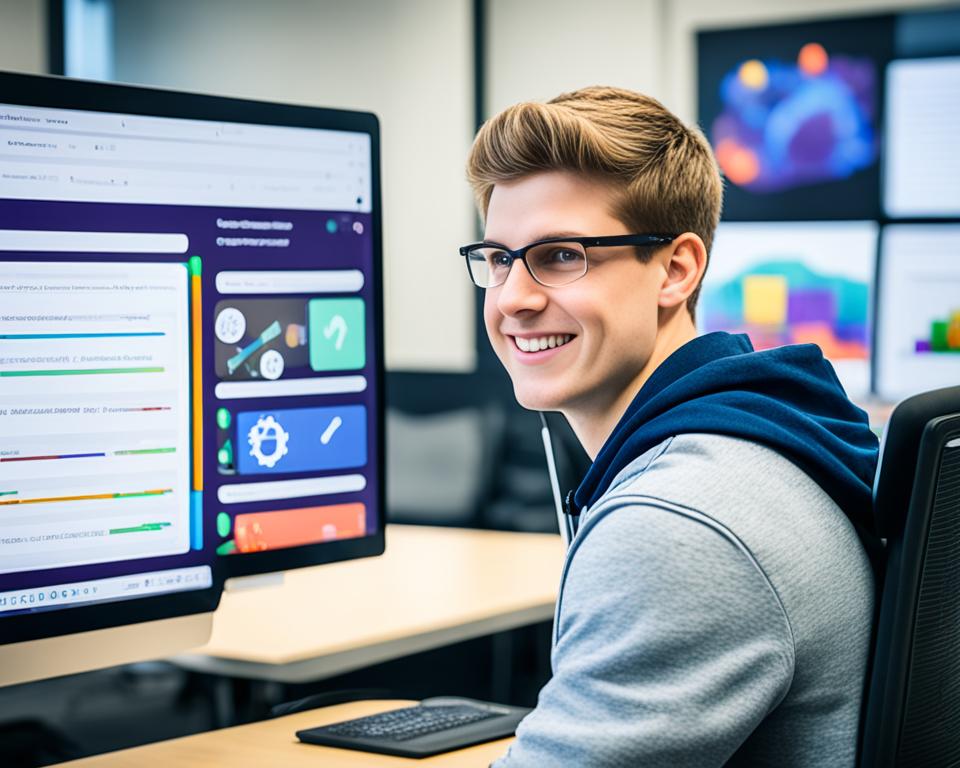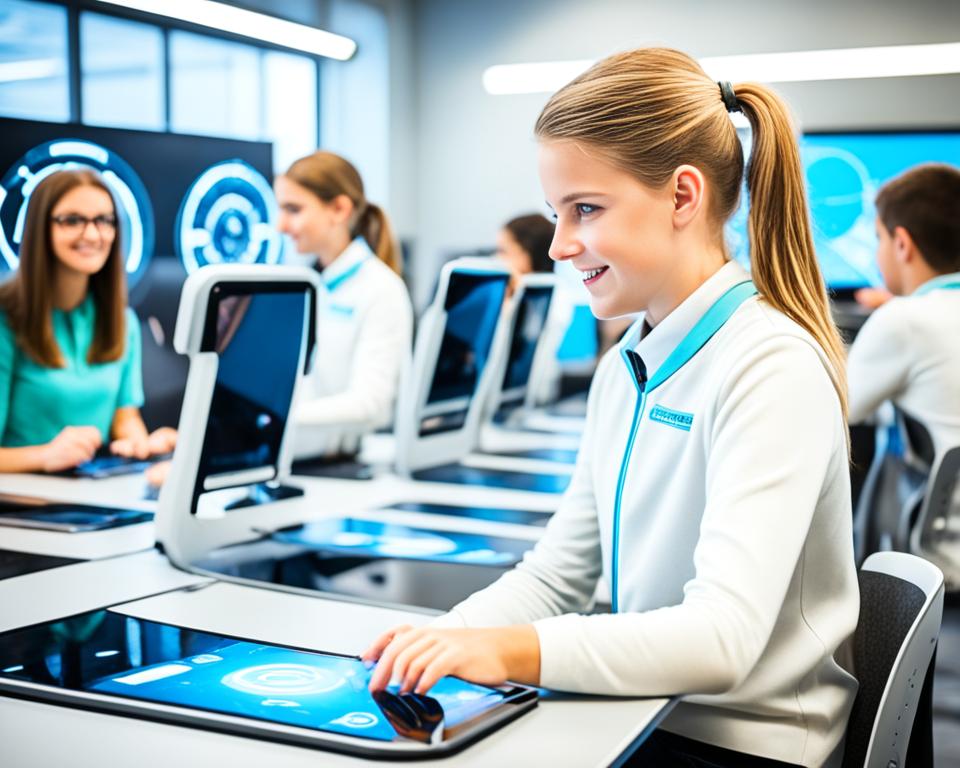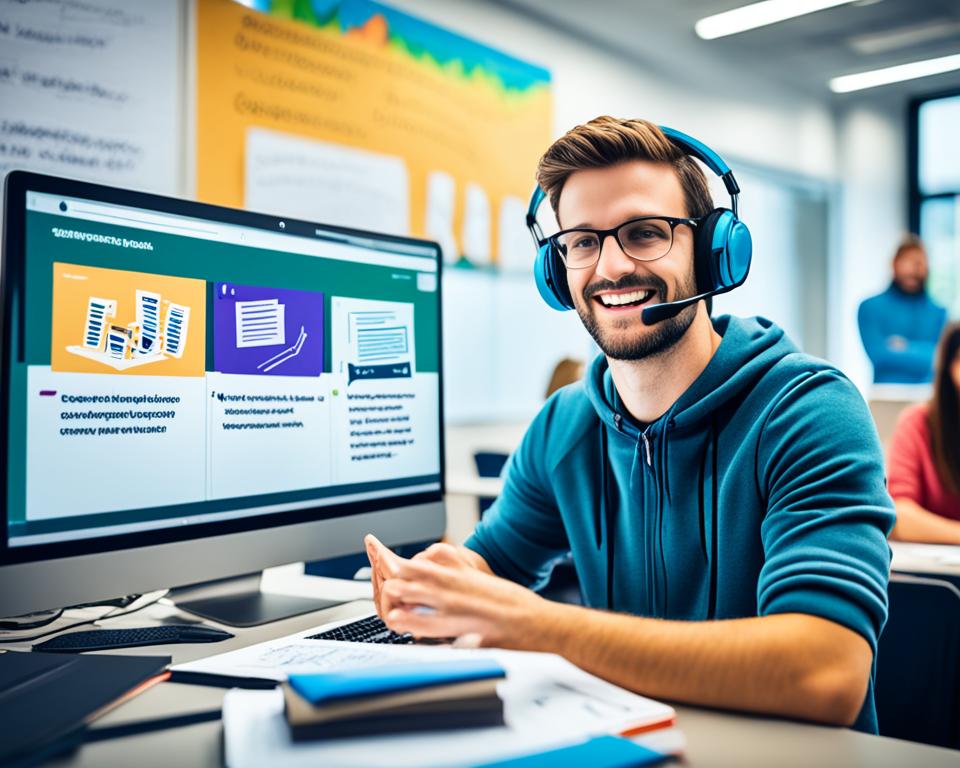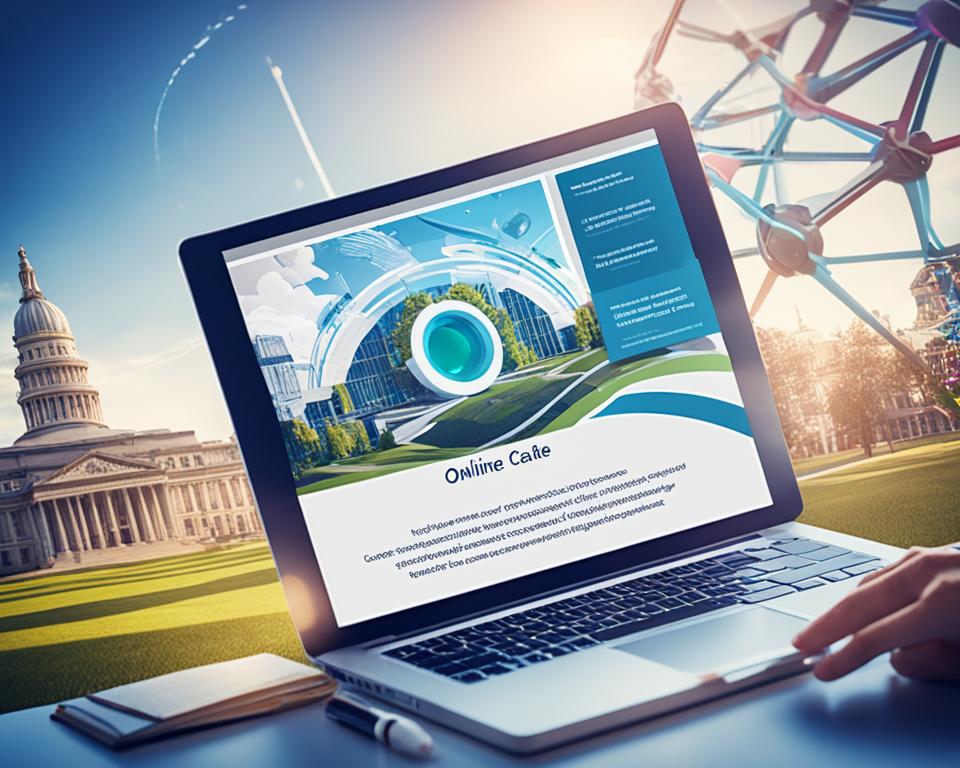Technology has revolutionized the way we access and deliver education, particularly in the realm of online learning. Advancements in technology have made e-learning more accessible, convenient, and engaging for students and teachers alike. From e-learning apps to virtual reality, technology is reshaping the landscape of education and paving the way for a future that combines traditional teaching methods with innovative approaches.
Key Takeaways
- Technology is transforming online learning by making it more accessible and convenient.
- E-learning apps, virtual reality, and other technologies are revolutionizing the learning process.
- The future of online learning will prioritize personalized, engaging learning experiences.
- Technology enables collaboration, global learning, and personalized instruction.
- Flexible learning spaces and supportive classroom furniture play a crucial role in the digital transformation of education.
The Impact of Technology on the Learning Process
Technology has revolutionized the learning process, bringing about significant changes in online education. By making educational materials more accessible, enabling collaboration among students and teachers, and providing interactive learning environments, technology has transformed the way we acquire knowledge and skills.
One of the most significant advancements facilitated by technology is the rise of online courses and Massive Open Online Courses (MOOCs). These platforms have democratized education by providing access to a vast array of courses from top institutions around the world. Students can now learn at their own pace, from anywhere and at any time.
Learning Management Systems (LMSs) and online platforms have streamlined content creation and distribution. Teachers can effortlessly upload and organize course materials, track student progress, and facilitate interactive discussions and assessments.
Collaboration tools have also played a crucial role in enhancing the learning experience. Students can now work together remotely, leveraging technologies such as video conferencing, instant messaging, and shared documents. This fosters teamwork, communication, and the exchange of ideas, making learning a more engaging and interactive process.
Educational software has transformed traditional teaching methods by offering innovative learning opportunities. With a wide range of educational apps and software available, students can engage with interactive simulations, multimedia presentations, and gamified learning experiences. This hands-on approach not only enhances understanding but also makes learning more enjoyable.
Virtual reality (VR) and augmented reality (AR) have introduced immersive learning experiences that significantly impact knowledge retention and engagement. By simulating real-world scenarios, VR and AR technologies provide students with a visually captivating and interactive learning environment. These technologies enable students to explore concepts in a practical and experiential manner, fostering a deeper understanding of complex topics.
“The integration of technology in education has brought about remarkable transformations, empowering learners and educators alike.”
| Benefits of Technology in Education | Examples |
|---|---|
| Increased access to educational materials | Online courses, MOOCs |
| Streamlined content creation and tracking | Learning Management Systems, online platforms |
| Enhanced collaboration among students | Video conferencing, instant messaging, shared documents |
| Engaging and interactive learning experiences | Educational software, VR, AR |
Technology has undoubtedly transformed the learning process, making it more accessible, interactive, and engaging. As technology continues to advance, the impact on education will only continue to grow, empowering learners of all ages to acquire knowledge and develop skills in innovative and exciting ways.
The Future of eLearning
In the ever-evolving landscape of education, eLearning continues to gain traction as a powerful tool for delivering knowledge. As technology advances, the future of eLearning holds the promise of virtual classrooms, scenario-based learning, decentralized platforms, and customized experiences.
Virtual Classrooms: Creating Interactive Learning Environments
Virtual classrooms enable teachers to transcend physical boundaries and create interactive and engaging learning environments. Through online whiteboards, streaming opportunities, and interactive videos and presentations, teachers can bring subjects to life and foster collaborative learning.
Scenario-Based Learning: Real-Life Simulations for Enhanced Understanding
Scenario-based learning is a powerful approach that leverages immersive technologies like augmented reality, virtual reality, and machine learning to provide real-life simulations. By placing students in simulated situations, they can apply their knowledge, develop critical thinking skills, and gain a deeper understanding of complex concepts.
Decentralized eLearning Platforms: Promoting Transparency and Autonomy
Decentralized eLearning platforms are on the horizon, offering greater transparency, security, and autonomy to students. These platforms enable students to access educational materials from various sources, expanding their learning resources and fostering a deeper understanding of the subject matter.
Customized Learning Experiences: Personalized Instruction and Support
The future of eLearning will prioritize customized learning experiences, tailoring instruction and support to meet the unique needs of individual students. Technology will play a pivotal role in providing personalized learning paths, adaptive assessments, and tailored feedback, ensuring that each student receives the support they need to succeed.
As technology continues to advance, the future of eLearning holds immense potential for revolutionizing education. With virtual classrooms, scenario-based learning, decentralized platforms, and customized experiences, students can embark on a journey where knowledge knows no bounds.
The Evolution of Technology in Education
The evolution of technology in education has transformed the way knowledge is accessed and acquired. From ancient times to modern-day advancements, various innovations have shaped the educational landscape, enabling new avenues for learning and collaboration.
The Printing Press: Revolutionizing the Spread of Knowledge
One significant milestone in the evolution of technology in education was the invention of the printing press in the 15th century. Johannes Gutenberg’s revolutionary creation enabled the mass production of books and printed materials, making knowledge more accessible and widespread. The printing press sparked a literacy revolution, as books became more affordable and available to a wider audience.
The Advent of Computers and the Internet
In the 20th century, computers and the internet ushered in a new era of educational possibilities. Computers brought computational power and interactive learning programs into classrooms, enhancing students’ understanding and engagement. The internet, a global network of interconnected computers, facilitated access to a vast amount of information, transforming the landscape of research and learning.
Enhancing Learning with Audiovisual Aids
Audiovisual aids have played a pivotal role in enriching the educational experience. From slide projectors to overhead projectors and multimedia projectors, these aids have visualized complex concepts, capturing students’ attention and supporting their understanding. Videos, images, and interactive presentations have proven to be valuable tools for delivering information in an engaging and memorable way.
Educational Software: Interactive Learning at Your Fingertips
The rising popularity of educational software has revolutionized how students learn and teachers instruct. Interactive and immersive learning programs provide personalized instruction, enabling students to grasp concepts at their own pace. Educational software bridges the gap between theoretical knowledge and practical application, fostering critical thinking and problem-solving skills.
The Era of Online Learning and Mobile Education
Online learning platforms and mobile technology have further transformed education, making learning accessible anytime, anywhere. Online courses and virtual classrooms have bridged geographical barriers, offering students a flexible and convenient way to gain knowledge. Mobile learning has made education portable, empowering students to access educational resources on their smartphones and tablets, expanding their learning opportunities beyond the traditional classroom.
The evolution of technology in education has opened up endless possibilities, improving accessibility, personalization, and collaboration. As technology continues to evolve, the future of education holds even more exciting prospects to empower learners and educators alike.
Personalized Learning with Technology
Technology plays a crucial role in creating personalized learning experiences for students. Through the use of data-driven software, adaptive learning technologies, and differentiated instruction, education can meet the unique needs of each individual learner.
Data-driven software allows educators to track student progress, strengths, and areas for improvement. By collecting and analyzing data, teachers can gain valuable insights into each student’s learning style, interests, and preferences. This information helps inform instructional strategies and curriculum design, ensuring that students receive tailored support and targeted interventions.
Adaptive learning technologies empower students to learn at their own pace and take ownership of their education. These technologies adapt the content, pace, and level of difficulty to match each student’s skill level. With personalized learning paths, students can explore topics of interest, while also receiving additional support in areas where they need it most.
With personalized learning, students have the freedom to explore their own interests, learn at their own pace, and take control of their educational journey. It empowers them to develop critical thinking skills, become self-directed learners, and achieve academic success.
Differentiated instruction is another essential component of personalized learning. It involves tailoring the curriculum to meet the diverse needs of individual students or groups of students. Teachers use a variety of instructional strategies, materials, and assessment methods to meet students where they are and help them achieve their full potential. This approach ensures that all students, regardless of their abilities or learning styles, receive an equitable and inclusive education.
By leveraging data-driven software, adaptive learning technologies, and differentiated instruction, educators can create tailored curriculum and personalized learning paths for their students. This approach fosters student engagement, motivation, and achievement, setting them up for lifelong success in an ever-changing world.
The Benefits of Personalized Learning
Personalized learning offers several benefits for students:
- Improved academic performance and higher achievement levels
- Increased student engagement and motivation
- Enhanced critical thinking, problem-solving, and decision-making skills
- Greater sense of ownership and responsibility for learning
- Development of self-directed learning skills
- Improved self-confidence and self-esteem
Overall, personalized learning with technology enables students to reach their full potential by providing them with the support, resources, and opportunities they need to succeed.

Democratized Learning through Technology
The integration of technology in education has revolutionized the learning landscape, paving the way for democratized learning opportunities. With the advent of online resources and e-platforms, education has become accessible to all students, regardless of their geographical location or physical abilities.
Online resources serve as a gateway to a wealth of educational materials, ensuring equal access for students worldwide. Whether it’s textbooks, research articles, or instructional videos, online resources eliminate geographical barriers and empower students with knowledge at their fingertips.
Furthermore, technology has opened doors for underserved areas, providing educational opportunities that were once unavailable. Students in remote or impoverished regions now have the opportunity to learn and thrive in the digital age, bridging the educational divide.
Inclusive education is a cornerstone of democratized learning, and technology plays a vital role in ensuring equal access for students with disabilities. Modified tech options, such as assistive devices and adaptive software, enable students with disabilities to engage fully in the learning process, breaking down barriers and promoting inclusivity.
“Technology has the potential to bring about a much-needed shift in educational equity. With online resources and modified tech options, we can ensure that every student, regardless of their circumstances, has an equal opportunity to learn and succeed.”
Benefits of Democratized Learning through Technology
By embracing technology, education becomes an inclusive and empowering experience. Here are some key benefits of democratized learning through technology:
- Equal access to educational materials for all students, regardless of location
- Opportunities for underserved areas to receive quality education
- Empowerment of students with disabilities through modified tech options
- Enhanced collaboration and knowledge-sharing on e-platforms
- Cultivation of diverse perspectives and global connections
Example of Online Resources and e-Platforms
| Online Resource/e-Platform | Description |
|---|---|
| Khan Academy | A comprehensive online learning platform offering instructional videos, practice exercises, and personalized learning dashboards. |
| Coursera | An online platform that partners with top universities to offer courses on a wide range of subjects, accessible to learners globally. |
| Bookshare | An accessible online library for individuals with print disabilities, providing access to a vast collection of books. |
| Brightspace | A learning management system that enables educators to create and deliver interactive online courses, fostering engagement and collaboration. |
These examples represent just a fraction of the vast array of online resources and e-platforms available today. With the continuous development of technology, the opportunities for democratized learning will only continue to expand, bringing education within reach for all.
Immersive and Engaging Learning Experiences through Technology
The use of immersive technologies such as virtual reality and augmented reality has revolutionized the learning experience by creating interactive and engaging environments. These technologies transport students to virtual worlds, making learning more exciting and memorable.
One emerging concept is the metaverse, a virtual version of real-life activities. With the metaverse, students can engage in immersive simulations and experiences, providing a hands-on approach to learning. Imagine exploring historical events, participating in scientific experiments, or even visiting remote locations without leaving the classroom.
Benefits of Immersive Technologies in Education
- Enhanced engagement: Immersive technologies capture students’ attention and provide a captivating learning experience. By actively participating in virtual environments, students become more engaged in the learning process.
- Interactive learning: Virtual reality and augmented reality allow students to interact with objects and manipulate virtual elements, fostering a deeper understanding of complex concepts.
- Multi-sensory experiences: Immersive technologies appeal to different learning styles by incorporating visual, auditory, and kinesthetic elements, resulting in a more comprehensive learning experience.
- Real-world applications: Virtual reality and augmented reality provide opportunities for students to apply their knowledge in real-world contexts, preparing them for future careers.
By incorporating immersive technologies into the curriculum, educators can enhance student engagement, promote critical thinking, and foster a deeper understanding of the subject matter.
Immersive technologies create a bridge between the physical and virtual worlds, opening up endless possibilities for interactive and experiential learning. Students can explore new concepts, engage in authentic simulations, and develop practical skills in a safe and controlled environment.
Through interactive learning experiences, technology transforms education, paving the way for a more engaging and effective learning journey.

Immersive technologies offer students the chance to explore new concepts in a hands-on and interactive way.
Collaboration and Global Learning with Technology
Technology has become a catalyst for collaboration and global learning, connecting students from different cultures and backgrounds. Through online platforms and tools, cross-cultural exchanges are enabled, fostering intercultural understanding and awareness.
Remote collaboration tools have transformed the way students work together, regardless of their physical location. Group projects and discussions can take place virtually, allowing for flexible schedules and increased productivity. This form of remote collaboration promotes teamwork, communication, and problem-solving skills, essential for the modern workforce.
Engaging in collaborative learning experiences not only nurtures personal and interpersonal skills but also contributes to the growth of cognitive abilities. When students work together, they exchange ideas, challenge assumptions, and gain new perspectives. This active engagement stimulates critical thinking, creativity, and complex problem-solving skills.
“The beauty of technology is that it brings people together, breaking down the barriers of distance and cultural differences. Collaborative learning is no longer confined to the physical classroom. It opens up a world of opportunities for students to connect, learn from one another, and develop essential skills for the globalized world.”
By embracing technology for collaboration and global learning, students gain exposure to diverse perspectives, fostering respect, empathy, and cultural competence. These attributes are crucial in an interconnected world where cross-cultural communication and collaboration are becoming increasingly important.
Here is a visual representation of how collaboration and global learning with technology can enhance cognitive skills growth:
| Benefits of Collaboration and Global Learning with Technology |
|---|
| Enhanced critical thinking and problem-solving skills |
| Improved communication and teamwork abilities |
| Increased cultural awareness and understanding |
| Expanded global perspectives and knowledge exchange |
| Development of adaptable and flexible thinking |
Through collaborative and global learning experiences, students have the opportunity to develop essential skills that will prepare them for the future. By leveraging technology, education becomes a borderless endeavor, fostering a sense of community, connection, and growth.
The Role of Classroom Furniture in the Digital Transformation
Classroom furniture plays a crucial role in creating supportive environments for the digital transformation in education. As schools embrace flexible learning spaces and ed tech integration, carefully selecting and arranging classroom furniture is key to enhancing student engagement and collaboration.
Here are some important tips for choosing and utilizing classroom furniture:
Create Flexible Learning Spaces
To accommodate different teaching methods and promote collaboration, classrooms should have flexible spaces that can be easily rearranged. Incorporate movable desks and chairs that can be easily rearranged to suit various learning activities and group sizes. This allows teachers to create adaptable learning environments that enable student interaction and engagement.
Accommodate Ed Tech Tools
With the increasing integration of educational technology in classrooms, it’s important to ensure that the furniture can accommodate these tools effectively. Provide ample space for laptops, tablets, and other devices, and consider furniture with built-in charging outlets and cable management systems. This helps create an organized and clutter-free learning environment, promoting seamless technology use.
Prioritize Comfort and Ergonomics
Comfortable and ergonomic furniture is essential for students’ well-being and concentration. Choose chairs and tables that support good posture and are adjustable to accommodate different student heights. Additionally, consider incorporating ergonomic accessories such as footrests, back supports, and adjustable keyboard trays to promote proper ergonomics and reduce the risk of discomfort or strain.
Enhance Collaboration and Interaction
Classroom furniture should facilitate collaboration and interaction among students. Opt for round or hexagonal tables that encourage face-to-face discussions and group work. Additionally, consider using soft seating areas or bean bags for informal gatherings and brainstorming sessions. These comfortable seating options create a relaxed environment that fosters creativity and collaboration.
Provide Ample Storage Options
Ample storage solutions help keep the classroom organized and clutter-free. Include storage cabinets, bookshelves, cubbies, or lockers where students can store their belongings and access learning materials easily. This promotes a tidy learning environment and reduces distractions, allowing students to focus on their studies.
| Benefits of Optimized Classroom Furniture | Keyword |
|---|---|
| Promotes student engagement and collaboration | student engagement, collaboration |
| Accommodates ed tech tools | ed tech integration, technology tools |
| Enhances comfort and ergonomics | comfortable furniture, ergonomic design |
| Facilitates collaboration and interaction | collaborative furniture, interactive learning |
| Provides ample storage options | storage solutions, organization |
By considering these classroom furniture tips and creating supportive learning environments, schools can maximize the benefits of technology integration and provide students with a comfortable and engaging education experience.
How to Make the Most of the Digital Transformation in Education
Schools that are embracing change and fostering innovation are poised to make the most of the digital transformation in education. By creating a supportive environment that encourages the effective use of technology, and by providing personalized support for teachers, schools can successfully integrate technology into their teaching styles.
One key aspect of making the most of the digital transformation is ensuring relevant technology use. It’s essential to choose technologies that align with the learning context and support learning outcomes. This means selecting tools and resources that enhance the curriculum and engage students in meaningful ways.
Personalized teacher support plays a vital role in optimizing technology integration. Teachers should receive training and ongoing professional development that focuses on using technology as a tool to enhance instruction. They should be provided with opportunities to explore and experiment with different technologies, allowing them to find innovative ways to engage their students.
Collaboration and sharing best practices among teachers can also be valuable in maximizing the benefits of the digital transformation. Schools can create spaces for teachers to collaborate, discuss challenges, and brainstorm ideas for using technology effectively in the classroom.
“The effective use of technology in education requires a shift in mindset. It’s not just about using technology for the sake of it, but rather using technology as a means to enhance teaching and learning.”
The Benefits of Making the Most of the Digital Transformation:
- Enhanced student engagement and motivation
- Improved access to educational resources
- Increased collaboration and communication
- Personalized learning experiences
- Development of essential digital skills
By fully embracing the digital transformation and fostering innovation, schools can create an environment where technology seamlessly integrates with teaching and learning. With personalized support for teachers and the strategic use of relevant technologies, education can be transformed to meet the needs of today’s learners and prepare them for the future.

The Future of Education Technology
In the ever-evolving landscape of education, technology continues to play a pivotal role in transforming the way we teach and learn. Looking ahead, advancements in augmented reality (AR), virtual reality (VR), and extended reality (XR) are set to revolutionize the educational experience, offering higher levels of engagement and creating immersive learning environments.
The integration of AR, VR, and XR technologies has the potential to redefine traditional teaching methods by providing interactive and realistic learning experiences. As costs decrease and accessibility improves, these immersive technologies will become more prevalent in classrooms, offering students the opportunity to explore subjects firsthand and engage with content in a way that goes beyond traditional textbooks and lectures.
With augmented reality, students can overlay digital content onto the real world, bringing abstract concepts to life and enabling them to visualize complex ideas. Virtual reality, on the other hand, transports students to virtual environments, creating immersive simulations and allowing for experiential learning. Extended reality combines elements of both AR and VR, blurring the lines between the physical and digital worlds and enhancing the overall learning experience.
“The integration of AR, VR, and XR technologies has the potential to redefine traditional teaching methods by providing interactive and realistic learning experiences.”
Through these immersive technologies, students have the opportunity to actively engage with the subject matter, making learning more dynamic and memorable. By immersing themselves in virtual worlds or overlaying digital information onto the real world, students can explore concepts, interact with virtual objects, and collaborate with their peers in ways that were previously unimaginable.
The future of education technology is not only limited to classrooms but extends to various fields such as medical training, architecture, and vocational education, where hands-on experience is crucial. By incorporating augmented and virtual reality into these fields, students can practice skills, simulate real-life scenarios, and make mistakes in a safe and controlled environment, fostering deeper understanding and mastery of their chosen profession.
Benefits of Immersive Technologies
The integration of augmented reality, virtual reality, and extended reality technologies in education offers several benefits:
- Enhanced engagement: Immersive technologies captivate students’ attention and make learning more exciting, motivating them to actively participate in the learning process.
- Improved understanding: By providing a multisensory experience, these technologies enable students to grasp abstract concepts more easily and develop a deeper understanding of the subject matter.
- Increased retention: Immersive learning experiences create lasting memories, as students associate information with interactive and memorable experiences.
- Promotion of creativity: Students can unleash their creativity by designing and building virtual worlds, fostering innovation and critical thinking skills.
- Flexibility in learning: Immersive technologies allow for personalized and self-paced learning, catering to individual students’ unique needs and learning styles.
As the future unfolds, the potential for augmented reality, virtual reality, and extended reality in education is boundless. With further technological advancements, these immersive technologies will continue to shape the way we teach and learn, paving the way for a more engaging and transformative educational experience.
| Benefits of Immersive Technologies in Education |
|---|
| Enhanced engagement |
| Improved understanding |
| Increased retention |
| Promotion of creativity |
| Flexibility in learning |
Conclusion
Technology has had a profound impact on the future of online learning, transforming the way education is accessed and delivered. The integration of technology in education has not only made learning more accessible and convenient, but it has also provided students and teachers with exciting opportunities for personalized learning experiences.
Through the use of technology, students now have greater access to educational resources, with online platforms and e-learning apps offering a wide range of courses and materials. This accessibility has democratized learning, bridging geographical gaps and ensuring that education is available to all, regardless of location or physical abilities.
The development of immersive technologies, such as virtual reality and augmented reality, has revolutionized the learning process by creating engaging and interactive learning environments. Students can now explore concepts through hands-on experiences, enhancing their understanding and retention of knowledge.
As technology continues to evolve, it will play a vital role in shaping the future of education. From personalized learning experiences to global collaboration, technology will ensure that learning remains relevant, accessible, and engaging for all. The possibilities are limitless, and the future of education looks bright with the integration of technology.
FAQ
How is technology shaping the future of online learning?
Technology is transforming the way we access and deliver education, making online learning more accessible and convenient for students and teachers. The future of online learning will be characterized by a combination of traditional and technology-driven approaches, providing engaging learning experiences.
What is the impact of technology on the learning process?
Technology has influenced the learning process by making educational materials more accessible, enabling collaboration among students and teachers, facilitating personalized learning experiences, and providing interactive learning environments through virtual and augmented reality. Online courses, Massive Open Online Courses (MOOCs), Learning Management Systems (LMSs), collaboration tools, and educational software have revolutionized education.
What does the future of eLearning look like?
The future of eLearning includes the development of virtual classrooms, scenario-based learning using immersive technologies like augmented reality and virtual reality, decentralized eLearning platforms, and customized learning experiences tailored to individual student needs.
How has technology evolved in education over time?
The evolution of technology in education dates back to the adoption of the printing press in the 15th century. Computers and the internet revolutionized education in the 20th century, offering new opportunities for research, collaboration, and online learning. Educational software, online platforms, and mobile learning have further enhanced the accessibility and convenience of education.
How does technology enable personalized learning experiences?
Technology enables personalized learning experiences by using data-driven software to track individual student strengths, interests, and needs. Adaptive learning technologies allow students to progress at their own pace, and differentiated instruction tailors the curriculum to meet the needs of individual students or groups, making learning more engaging and effective.
How has technology democratized learning?
Technology has democratized learning by providing online resources and e-platforms that extend educational opportunities to all students, regardless of their geographical location or physical abilities. Online resources allow for equal access to educational materials, and modified tech options ensure that students with disabilities can fully participate in the learning process. Technology has opened doors for underserved areas and marginalized students, providing them with educational opportunities that were previously unavailable.
How does technology enhance immersive and engaging learning experiences?
Technology, such as virtual reality and augmented reality, enhances learning by creating interactive and engaging experiences. The metaverse, a virtual version of real-life activities, has the potential to revolutionize learning by offering immersive simulations and experiences. These technologies make learning more exciting and memorable, allowing students to explore new concepts in a hands-on and interactive way.
How does technology facilitate collaboration and global learning?
Technology connects students from around the world, enabling cross-cultural exchanges and fostering intercultural understanding and awareness. Remote collaboration tools facilitate group work and project-based learning, regardless of physical location. Collaborative learning experiences enhance personal, interpersonal, and cognitive skills growth, preparing students for the globalized world.
What is the role of classroom furniture in the digital transformation?
Classroom furniture plays a crucial role in creating supportive environments for the digital transformation in education. Flexible learning spaces that can adapt to different teaching methods and accommodate ed tech tools are essential. Proper classroom furniture enhances engagement and collaboration, providing students with comfortable and ergonomic workspaces.
How can schools make the most of the digital transformation in education?
Schools can make the most of the digital transformation by embracing change and fostering innovation. They can create a supportive environment where technology can be used effectively, and teachers receive personalized support to integrate technology into their teaching styles. Relevant technology use is essential, ensuring that technology aligns with the learning context and supports learning outcomes.
What does the future of education technology look like?
The future of education technology will see advancements in augmented reality, virtual reality, and extended reality. These immersive technologies have the potential to create higher levels of engagement throughout the learning process. As costs decrease, the integration of augmented and virtual reality will become more prevalent, providing students with interactive and realistic learning experiences.
What is the conclusion regarding technology and online learning?
Technology has significantly shaped the future of online learning, revolutionizing the learning process and offering new opportunities for students and teachers. The integration of technology in education has led to personalized learning experiences, greater access to educational resources, and the development of immersive and engaging learning environments. As technology continues to evolve, it will play a crucial role in shaping the future of education, ensuring that learning remains relevant, accessible, and engaging for all.





